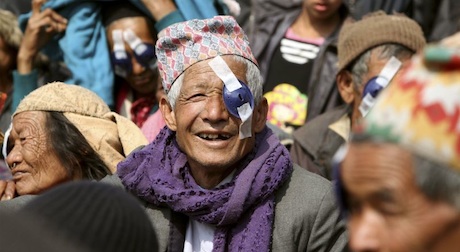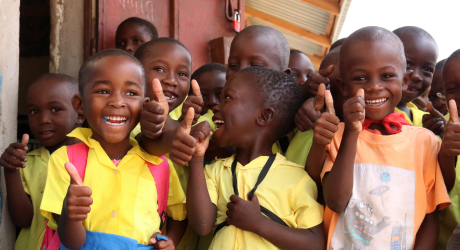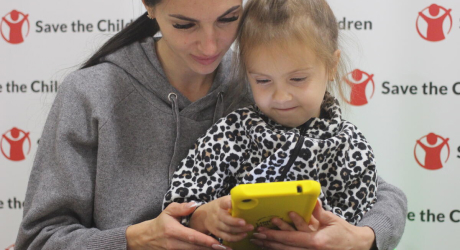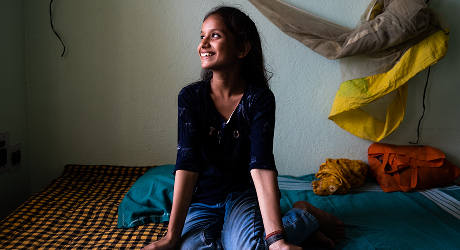Footprints Project
Since 2005, travelers like you have helped us change the world through micro-donations.

-
A total of
7277
Travelers
-
donated
$30009.51
(100% funded) -
to help improve
Health
-
impacting
20000
people -
in
Nepal
Project Aim
To reduce avoidable blindness and visual impairment in the Far Western Development Region of Nepal
Background on this issue
It is estimated that 90% of Nepal’s blind population live in rural remote Nepal and 80% of these cases are avoidable. In addition, children represent 43% of the regional population. The vast majority of Nepal’s rural population have no access to eye health care.
The Far West Development region of Nepal covers an area of 19,539 square km and a population of approximately 3 million people. It is the least developed region in Nepal as a result of its isolation at the extreme west of the country. The region has limited access to basic services and increasing services is challenging due to the difficult topography.
Within the Far West Development Region, eye care services and health in general are limited mostly to the urban areas.
Geta Eye Hospital, situated in the Kailali district is the only service provider of the 9 district region. Seven of these districts are hilly with poor transportation and other infrastructure facilities. Remote villages of
these districts are quite far away which takes about 1 to 5 days of trek- king from the nearest road head.
Retaining adequate eye health staff remains a challenge in this region. Of 147 Ophthalmologists, only 4 are located in the Far Western Development Region, even though approximately 11% of the population live here.
Project Objectives
- Increase access to eye care services for remote population of Far Western Development Region of Nepal
- Provide comprehensive eye care services at district hospital through establishment of Sub Specialty Clinic
- Human resources development for clinical and managerial roles at district level
- Strengthen referral system by providing eye care training to grassroots level community groups
- Increase utilisation of eye care facilities through community awareness about avoidable eye diseases and eye care services
- Promote cornea donation
Key Achievements in Nepal
Helping People See:
- 374,922 people were screened
- 14,369 cataract surgeries
- 19 outreach microsurgical eye camps in rural and remote areas
Number of people trained:
- 6 surgeons
- 34 clinic support staff
- 2,779 community health workers
Other achievements:
- Continued to build community awareness through the production and distribution of educational materials through community health volunteers into schools and hospitals
- Community announcements raising awareness of the availability of eye care services were aired in 96 locations through 3 different FM Radio stations which reached a population of 450,000 people
- Conducted training of staff in 12 key areas which included health systems and general business administration
Lakpa’s Story
82-year-old Lakpa Tamang had been blind in both eyes for several years. When we first met him, he had walked for hours to get to the outreach camp north of Kathmandu. Like many of the patients he was barefoot and in tattered clothes.
Lakpa was lucky enough to be operated on by world-renowned surgeon, Dr Ruit, who removed his cataracts quickly.
Two days later, Lakpa’s life is transformed. He’s given new clothes and his patches are taken off. He looks around the beautiful temple in amazement.
The prospect of walking back home to his village without help puts Lakpa into a wonderful grin. He can’t wait to see his grandchildren.
What's Next?
The Fred Hollows Foundation will continue to work with our partners into 2015. The overarching Regional Eye Care Project in Nepal will continue to focus on building capacity and increasing service coverage beyond urban centres.
This year our work in Nepal is:
- Training 3 surgeons and 5 clinic support staff
- 395 community health workers will be trained in basic and primary eye care
- Further eye screening camps will be undertaken in rural areas
- Outreach microsurgical eye camps will be conducted in remote and under serviced areas
- Eye health education will be continued to raise community awareness
- Screen 60,000 people
- Perform 2,750 cataract surgeries
- Relief efforts will continue to be offered through The Tilganga Institute of Ophthalmology for those affected by the devastating earthquakes.
Traveling soon? When you buy travel insurance with us, you can make a contribution towards a cause you care about.
Get a quote






